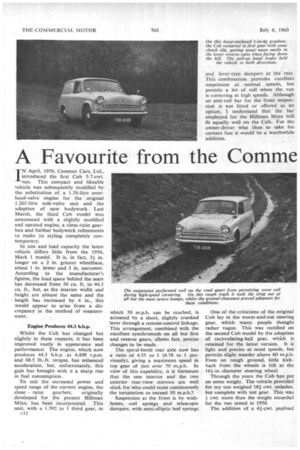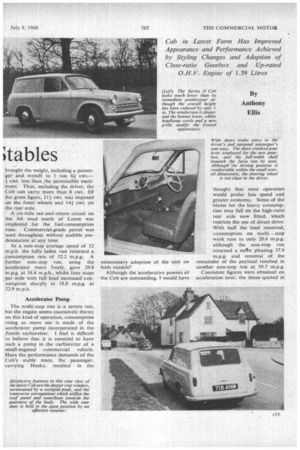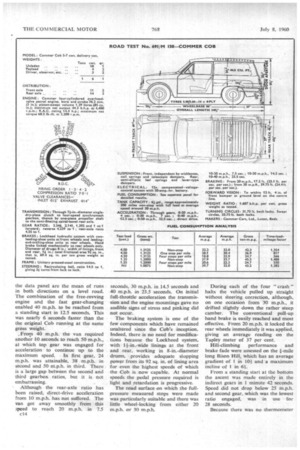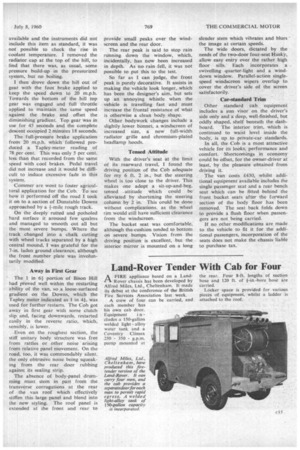A Favourite from the Comme
Page 48

Page 49

Page 50

Page 51

If you've noticed an error in this article please click here to report it so we can fix it.
Cob in Latest Form Has Improved Appearance and Performance Achieved by Styling Changes and Adoption of Close-ratio Gearbox and Up-rated
Q.H.V. Engine of 1.39 Litres
By Anthony Ellis
IN April, 1956, Commer Cars, Ltd., introduced the first Cob 5-7-cwt. van. This compact and likeable vehicle was subsequently modified by • the substitution of a 1.39-litre overhead-valve engine for the original 1.265-litre side-valve unit and the adoption of new bodywork. Last March, the third Cob model was announced with a slightly modified and uprated engine, a close-ratio gearbox and further bodywork refinements to make its styling completely contemporary.
In size and load capacity the latest vehicle differs little from the 1956, Mark 1 model. It is, in fact, 34 in. longer on a 2 in. greater wheelbase, about 1 in. lower and 3 in. narrower. According to the manufacturer's figures, the load space behind the seats has decreased from 56 Cu. ft. to 44.5 cu. ft., but, as the interior width and height are almost the same and the length has increased by 4 in., this would appear to arise from a discrepancy in the method of measurement.
Engine Produces 44.3 b.h.p.
. Whilst the Cob has changed but slightly in these respects, it has been improved vastly in appearance and performance. The engine, which now produces 44.3 b.h.p.. at 4,400 r.p.m. and 68.5 lb.-ft. torque, has enhanced acceleration, but, unfortunately, this gain has brought with it a sharp rise in fuel consumption.
To suit the increased power and speed range of the current engine, the
close ratio gearbox, originally developed for the present Hillman Minx, has been incorporated. This unit, with a 1.392 to I third gear, in c12 which 50 m.p.h. can be reached, is actuated by a short, slightly cranked lever through a remote-control linkage. This arrangement, combined with the excellent synchromesh on all but first and reverse gears, allows fast, precise changes to be made.
The spiral-bevel rear axle now has a ratio of 4.55 to 1 (4.78 to I previously), giving a maximum speed in top gear of just over 70 m.p.h. In view of this capability, it is fortunate that the one interior and the two exterior rear-view mirrors are well sited, for who could resist continuously the tern ptation. to exceed 30 m.p.h.?
Suspension at the front is by wishbones, coil springs and telescopic dampers, with semi-elliptic leaf springs an.d lever-type dampers at the rear.
• This combination provides excellent suspension . at normal speeds, but permits a lot of. roll when the van is cornering at high speeds. Although an anti-roll bar for the front suspen
• siori is not fitted or offered as an Option, I understand that the bar employed for the Hillman. Minx will fit equally well on the Cob. For the owner-driver who likes: to take his corners fast it would be a worthwhile addition.
One of the criticisms of the original Cob lay in the worm-and-nut steering gear, which many people thought rather vague. This was rectified on the second Cob model by the adoption of recirculating-ball gear, which is retained for the latest version. It is tight and precise at most speeds, but permits slight wander above 60 m.p.h. Even on rough ground, little kickback from the wheels is felt at the 164-in.-diameter steering wheel.
Through the years the Cob has put on some weight. The vehicle provided for my test weighed 181 cwt. unladen, but complete with test gear. This was cwt. more than the weight recorded for the van tested in 1956.
The addition of a 44--cwt. payload brought the weight, including a passenger and myself to I ton 6+ cwt.— cwt. less than the permissible maximum. Thus, including the driver, the Cob can carry more than 8 cwt. Of the gross figure, 11+ cwt. was imposed on the front wheels and 141 cwt. on the rear axle.
A six-mile out-and-return circuit on the A6 road north of Luton was employed for the fuel-consumption runs. Commercial-grade petrol was used. throughout without audible predetonation at any time.
At a non-stop average speed of 32 m.p.h. the fully laden van returned a consumption rate of 32.2 m.p.g. A -further non-stop run, using the accelerator . more freely, gave 29,8 m.p.g. at 34.6 m.p.h., whilst four stops per mile with full load increased consumption sharply. to 18.8 m.p.g. at 22.9 m.p.h.
Accelerator Pump
Themulti-stop run is a severe test, but the engine seems excessively thirsty on this kind of operation, consumption rising as more use is made of the accelerator pump incorporated in the Zenith carburetter. I find it difficult to believe that it is essential to have such a pump in the carburetter of asmall-engined commercial vehicle. Have the performance demands of the Cob's stable mate, •the passengercarrying Husky, resulted in the unnecessary adoption of the unit on both models?
Although the accelerative powers of the Cob are outstanding, I would have thought that most operators • would prefer less speed and greater economy. Some of the blame for the heavy consumption may fall on the high-ratio rear axle now fitted, which restricts the use of direct drive. With half the load removed, consumption on multi stop work rose to only 20.6 m.p.g. although the non-stop run returned a mere pleasing 37.9 m.p.g. and removal of the remainder of the payload resulted in another non-stop test at 39.7 m.p.g.
Consistent figures were obtained on acceleration tests; the times quoted in the data panel are the mean of runs in both directions on a level road. The combination of the free-revving engine and the fast gear-changing enabled 40 m.p.h. to be reached from a standing start in 12.5 seconds. This was nearly 6 seconds faster than the the original Cob running at the same gross weight.
From 40 m.p.h. the van required another 10 seconds to reach 50 m.p.h., at which top gear was engaged for acceleration to continue up to the maximum speed. In first gear, 24 m.p.h. was attainable, 38 m.p.IL in second and 50 m.p.h. in third. There is a large gap between the second and third gearbox ratios, but it is not embarrassing.
Although the rear-axle ratio has been raised, direct-drive acceleration from 10 m.p.h. has not suffered. The van got away smoothly from this ;peed to reach 20 m.p.h. in 7.5
c I 4
seconds, 30 m.p.h. in 14.5 seconds and 40 m.p.h. in 23.5 seconds. On initial full-throttle acceleration the transmission and the engine mountings gave no audible signs of stress and pinking did not occur.
The braking system is one of the few components which have remained unaltered since the Cob's inception. Indeed, there is no need for modifications because the Lockheed system, with 11-in.-wide linings at the front and rear, working in 8-in.-diameter drums, provides adequate stopping power from its 92 sq. in. of lining area for even the highest speeds of which the Cob is now capable. At normal speeds the pedal pressure required is light and retardation is progressive.
The road surface on which the fullpressure measured stops were made was particularly suitable and there was little wheel-locking from either 20 m.p.h. or 30 m.p.h. During each of the four " crash" halts the vehicle pulled up straight without steering correction, although, on one occasion from 30 m.p.h., it drifted slightly -down the rather steep camber. The conventional pull-up hand brake is easily reached and most effective. From 20 m.p.h. it locked the rear wheels immediately it was applied, giving an average reading on the Tapley meter of 37 per cent.
Hill-climbing performance and brake fade were assessed on the 4-mile long Bison Hill, which has an average gradient of 1 in 101 and a maximum incline -of 1 in 61.
From a standing start at the bottom the ascent was made entirely in the indirect gears in 1 minute 42 seconds. Speed did not drop below 25 m.p.h. and second gear, which was the lowest ratio engaged, was in use for 28 seconds.
Because there was no thermometer available and the instruments did not include this item as standard, it was not possible to check the rise in coolant temperature. I removed the radiator cap at the top of the hill, to find that there was, as usual, some pressure build-up in the pressurized system, but no boiling.
I then drove down the hill out of gear with the foot brake applied to keep the speed down to 20 m.p.h. Towards the bottom of the hill top gear was engaged and full throttle applied to maintain •the same speed against the brake and offset the diminishing gradient. Top gear was in use for 45 seconds and, the complete descent occupied 2 minutes 18 seconds.
The full-pressure brake application from 20 m.p.h. which followed produced 'a Tapley-meter reading of 78 per cent. This was only 5 per cent. less than that recorded from the same speed with cool brakes. Pedal travel did not increase and it would be difficult to induce excessive fade in this system.
Comrner are wont to foster agricultural application for the Cob. To see how it 'performed off the road I took it on to a section of Dunstable Downs approached by a +-mile rough track.
On the deeply rutted and potholed hard surface it aroused few qualms and managed to smooth out all but the most severe bumps. Where the track changed into a chalk cutting with wheel tracks separated by a high central mound, I was grateful for the 7-in. laden ground clearance, although the front number plate was involuntarily modified.
Away in First Gear
The 1 in 6+ portion of Bison Hill had proved well within the restarting ability of the van, so a loose-surfaced gradient on the Downs, which the Tapley meter indicated as 1 in 41, was used for further restarts. The Cob got away in first gear with some clutch slip and, facing downwards, restarted easily in the reverse ratio, which, sensibly, is lower.
Even on the roughest section, the stiff unitary body structure was free from rattles or other noise arising from relative panel movement, On the road, too, it was commendably silent, the only obtrusive noise being squeaking from the rear door rubbing against its sealing strip.
The absence of body-panel drumming must stem in part from the transverse corrugations at the rear of the van roof which effectively stiffen this large panel and blend into the new styling. The roof panel is extended at the front and rear to provide small peaks over the windscreen and the rear door.
The rear peak is said to stop rain running down the window, which, incidentally, has now been increased in depth. As no rain fell, it was not possible to put. this to the test.
So far as I can judge, the front peak is purely decorative. It assists in making the vehicle look longer, which has been the designer's aim, but sets up an annoying whistle when the vehicle is travelling fast and must increase the frontal resistance of what is otherwise a clean body shape.
Other bodywork changes include a slightly lower bonnet, a windscreen of increased size, a new full-width radiator grille and chromium-plated headlamp hoods.
Tensed Attitude
. With the driver's seat at the limit of its rearward travel, I found the driving position of the Cob adequate for my 6 ft. 2 in., but the steering wheel is too close to the driver. This makes one adopt a sit-up-and-beg, tensed . attitude which could be alleviated by shortening the steering column by 2 in. This could be done without complications, as the wheel rim would still have sufficient clearance from the windscreen.
The bucket seat was comfortable, although the, cushion tended to bottom on severe bumps. Vision from the driving position is excellent, but the interior mirror is mounted on a long slender stem which vibrates and blurs ' the image at certain speeds.
The wide doors, dictated by the needs of the two-door four-seat Husky, allow easy entry over the rather high floor sills. Each incorporates a swivelling quarter-light and a winddown window. Parallel-action singlespeed windscreen wipers overlap to cover the driver's side of the screen satisfactorily.
Car-standard Trim Other standard cab, equipment includes a sun visor on the driver's side only and a deep, well:finished, but oddly shaped, shelf beneath the dash
board. The interior trim, which is continued to waist level inside the body, is up to private-car standards.
In all, the Cob is a most attractive vehicle for its looks, performance and comfort. Shortcomings in economy could be offset, for the owner-driver at least, by the pleasure. obtained from driving it.
The van costs £430, whilst additional equipment available includes the single passenger seat and a rear bench seat which can be fitted behind the front bucket seats after the forward section of the body floor has been remoVed. The seat back folds down to provide a flush floor when passengers are not being carried.
If no other modifications are made to the vehicle to tit it for the additional passengers, incorporation of the seats does not make the chassis liable to purchase tax.








































































































